What to Eat For Your Menstrual Cycle: Four Phases
Learn how to eat for all phases of your menstrual cycle to help your body be as healthy as possible. This article shares specific ways on how we can use nutrition to help support hormone balance and ease of period symptoms throughout the month. I’ve included foods lists for all phases including: menstrual, follicular, ovulatory, and luteal.

What Can Your Cycle Tell You About Your Overall Health?
For cycling women of all ages, it’s important to be aware of the ways that nutrition and food choices can support our hormones.
- Our menstrual cycles can be a quick measure of our overall health. The relative ease and regularity of your menstrual cycle is an amazing piece of information that gives you insight about your overall health. In fact, some health professionals consider it to be the 5th vital sign.
- The menstrual cycle is so important because it indicates whether or not a woman is healthy and safe enough to reproduce. Reproduction is not essential to survival, so it is often the first system to “shut off” in times of illness or stress.
- This ability to stop menstruating is the body’s protection mechanism not to get pregnant in a less than optimal environment. Historically, this often occurred due to famine or other life-threatening circumstances. Today, a lack of a normal cycle occurs due to stress, imbalanced hormones, or lack of nourishment.
- It is normal to have some variations in our cycles. Even the season can cause changes. Certainly, one’s age, stage of life, and level of stress can also cause changes. But, painful periods, severe menstrual cramps or menstrual pain, and very heavy blood loss during that time of the month may be signs that you need to work on hormone levels using the right foods and a healthy diet.
- Most women between the ages of 12-50 have between 10-12 cycles a year. Menstrual cycles should generally be between 28-35 days, though this number may vary slightly. As long as your cycle is normal for you and is consistent, that is considered a good sign.
As always, it’s important to consult your healthcare provider if you have changes in your cycle or if you miss more than a couple of cycles and you aren’t pregnant.
Overview of Four Menstrual Phases
We often think of menstruation as the main event of a cycle, but there are actually four phases in a cycle. The two main parts are the follicular and luteal phases, but they can be broken up further into the menstrual, follicular, ovulatory, and luteal phases.
One way to monitor your changes from phase to phase is to keep a journal of how you are feeling each day and what food cravings or mood changes you have.
Here is a more details description of the four parts of the female menstrual cycle. Note that there will be some variation in the timing based on each individual female.
Menstrual Phase (Days 1-5)
The first day of bleeding marks the first day of your entire cycle. Menstruation occurs from days 1-5, though your specific period length may look different. Anywhere from 2-7 days is considered normal, though most women bleed between 3-5 days.
During the menstrual phase, you are shedding your uterine lining from the previous cycle. All hormones are low for the first few days, with estrogen and FSH (follicle stimulating hormone) begin to rise towards the end. Your body is also busy maturing several eggs for ovulation.
See below for the best foods to eat on your period.
Follicular Phase (Days 6-15)
After you stop bleeding, you move into your follicular phase, which occurs from days 6-15 (or from the last day of bleeding to ovulation). During this time, your body selects one dominant follicle to nurture and grow in preparation for ovulation.
I’ve include a list below of foods to eat during the follicular phase.
Estrogen rules this part of your cycle, along with luteinizing hormone to trigger ovulation. The end of the follicular phase is marked by ovulation, when the follicle bursts and releases an egg ready for fertilization.
Ovulatory Phase (Days 16-21)
Immediately after ovulation, your body is prepared for a fertilized egg to implant itself in your uterus. The ovulatory phase lasts from the end of ovulation to the luteal phase, roughly days 16-21.
During this luteal phase, progesterone rises, prompting the continued growth of a nutrient-dense uterine lining ready for implantation. The dominant follicle, now referred to as the corpus luteum, is primarily responsible for secreting the progesterone that will ensure a successful pregnancy if the egg has been fertilized.
See below for what to eat when you’re ovulating.
Luteal Phase (Days 21-30)
From days 21-30, or the week before your next period, your body has gotten the message that is is not pregnant (if the egg is not fertilized). Thus, it begins preparing to shed the uterine lining and repeat the cycle again. As the corpus luteum begins dying, it takes progesterone with it. Estrogen remains lower as well.
This phase is when many women experience premenstrual syndrome, or PMS. PMS often occurs due to low progesterone levels, usually a result of poor follicle creation and/or unsuccessful ovulation (meaning the egg was not healthy enough or you did not ovulate at all.)
Your luteal phase ends with the first day of real bleeding, marking the first day of your next cycle. See below for the best luteal phase foods.
How to Eat for Each Phase of Your Cycle
Your diet is a great way to optimize each phase of your cycle. Not only do you get to target potential symptoms with key nutrients, but your cycle is a built-in way to rotate your foods and ensure variety in your diet.
Here are some tips for what to eat on your period to support balanced hormones and your optimal energy and well-being. Remember to always use Non Toxic Pans when cooking.
Don’t worry if you can’t incorporate specific foods during each phase, but you might want to test if cycle syncing at least a few meals helps manage any unpleasant symptoms that you experience.
Foods for Menstrual Phase (Days 1-5)
Body Needs: Your menstrual phase is a time to rest and replenish. Your body is undergoing a controlled inflammatory response to shed your uterine lining, so nourishing yourself with nutrient-dense, anti-inflammatory foods will help support you during your period.
Due to blood loss, iron-containing foods are the most important while on your period. Most women also need an iron supplement (see my recommendations of supplements for women of child-bearing age).
Foods to Eat (including iron-rich and mineral-rich foods):
- Beets
- Broccoli
- Brown Rice
- Chia Seeds
- Dark Chocolate (in moderation)
- Fatty Fish (like salmon and mackerel)
- Ginger
- Iron-rich foods (spinach, lentils, beef)
- Kelp and Seaweeds
- Quinoa
- Turmeric
- Walnuts
- Water-rich fruits (watermelon, cucumber)
A sample meal for your menstrual phase could include Instant Pot Sweet Potato & Beef Chili and a salad filled with iron-rich spinach, high-antioxidant berries, and healthy fats like sliced avocado and olive oil.
Additional Foods to Consider: You can try adding an Adrenal Cocktail to improve your electrolyte levels too. Beet Juice contains plant-based iron and minerals. Nourish your magnesium levels and your mood with a few daily squares of dark chocolate or my recipe for Healthy Hot Chocolate.
Foods to Avoid:
- Sugary foods like candy and cookies.
- Dairy products like milk which may cause bloating and cramping.
- Alcohol which can dehydrate the body.
Foods for the Follicular Phase (Days 6-15)
Body Needs: A lot of women feel best during their follicular phase when the body’s fertility efforts are more behind the scenes. Enjoy a normal balanced diet during this phase, incorporating plenty of nourishing foods to provide nutrients to a maturing follicle.
If you are trying to conceive, this is the best time to focus on hormone balance and optimizing fertility. I’ve included specific foods to include and avoid during this time leading up to ovulation.
Foods to Eat Follicular Phase (including nutrient-dense foods):
- Avocados
- Berries (blueberries, strawberries, raspberries)
- Eggs
- Fermented Foods (yogurt, sauerkraut, kimchi)
- Leafy Greens (spinach, kale, Swiss chard)
- Legumes (lentils, chickpeas, beans)
- Lean Proteins (chicken, turkey, fish, tofu)
- Nuts and Seeds (flaxseeds, pumpkin seeds, sunflower seeds)
- Whole Grains (quinoa, barley, oats, whole wheat bread)
A sample meal for your follicular phase could include nutrient-dense salad with with lots of vegetables, sauerkraut, grilled chicken, and avocado. You could also add a Green Vegetable Juice to your diet to help add extra micronutrients.
Additional Foods to Consider: Some women find themselves prone to dehydration during their follicular phase due to the high levels of hormones, so incorporate more mineral-rich sea salt and water during this time (try my recipe for Cucumber Ginger Lemon Water or homemade Celery Juice).
Foods to Avoid During Follicular Phase:
- Alcohol which can affect hormone balance and overall liver function.
- Too much caffeine which may impact estrogen levels.
- Highly processed foods like fast foods or fried foods that can contain additives, high salt, and unhealthy fats, which can impact overall health and hormone balance.
- Too much soy or phytoestrogen-containing foods which can affect estrogen balance.
Foods for the Ovulatory Phase (Days 16-21)
Body Needs: During your ovulatory and luteal phases (the rest of your cycle leading up to when you start bleeding), you want to start supporting your detoxification pathways to make it easy to metabolize and eliminate the used hormones from your follicular phase.
Focus on liver-loving foods like cruciferous vegetables, antioxidant-rich berries, and protein. Incorporate plenty of fiber to ensure you’re able to eliminate properly.
Foods to Eat (including detoxifying foods):
- Asparagus
- Berries (strawberries, raspberries, blueberries)
- Brazil nuts
- Chia seeds
- Eggs
- Flaxseeds
- Green leafy vegetables (spinach, kale)
- Lean meats (chicken, turkey)
- Quinoa
- Salmon
- Sunflower seeds
- Tuna
- Walnuts
- Zinc-rich foods (oysters, pumpkin seeds, beef, cashews)
You may consider eating easily digestible foods since some women can start to have digestive issues during this phase. One way to do this is to cook your vegetables, as opposed to eating raw veggies during this time.
A sample meal for your luteal phase could include a pureed soup, which is typically easy to digest. A dairy-free broccoli pureed soup is a great option (see all of my dairy-free soup recipes). Or, try my Liver Detox Smoothie that is very nourishing and naturally detoxifying.
You may also wish to follow a Sugar Detox Meal Plan to help with sugar cravings.
Additional Foods to Consider: Try adding some homemade broccoli sprouts to also help with your body’s natural detox pathways. Cinnamon Water can help manage blood sugar levels.
You can also try eating more foods with natural probiotics such as sauerkraut and coconut yogurt to help with any digestive issues during the luteal phase.
Foods to Avoid:
- Sugary foods which can affect mood and energy.
- Trans fats that can negatively impact hormone production and overall reproductive health.
Foods for the Luteal Phase (Days 21-30)
Body Needs: To help stave off cramps, headaches, and difficulty sleeping during the luteal phase of your menstrual cycle, you should definitely include magnesium-rich foods while continuing to support your detox pathways.
Foods high in magnesium include nuts and seeds, leafy greens, avocado, chocolate, and bananas. If you have trouble with allergies during this time, try my tips for how to reduce histamine naturally.
Foods to Eat During Luteal Phase:
- Almonds
- Avocado
- Bananas
- Brown rice
- Chickpeas
- Chocolate (in moderation)
- Dark leafy greens (spinach, kale)
- Eggs
- Lentils
- Peanuts
- Pumpkin seeds
- Quinoa
- Salmon
- Sweet potatoes
- Turkey
- Whole grains (like barley and oats)
- Zucchini
A sample meal for your premenstrual phase may include a Chocolate Cherry Smoothie made with magnesium-rich banana, cherries, and cocoa powder. Toss in some cruciferous kale or cauliflower to your smoothie for extra detox support. See my related article on the Health Benefits of Green Smoothies.
Additional Foods to Consider: Try adding a Turmeric Shot to your diet to help reduce inflammation. Also try adding a Raw Carrot Salad to your diet to help with estrogen metabolism during this phase of your cycle.
Lastly, you could try eating more of these progesterone-boosting foods to help prevent symptoms of lowered progesterone during this time in your cycle.
Foods to Avoid During Luteal Phase:
- Alcohol which an exacerbate mood swings and disrupt sleep.
- Caffeine in excess can intensify breast tenderness and disrupt sleep patterns.
- Sugary foods which may contribute to premenstrual migraines and mood swings. See my list of the best no-sugar foods.
- High-sodium foods that may contribute to bloating and water retention.
Cycle Syncing Diet FAQs
Seed cycling, or the practice of ingesting different seeds for the two major phases of your cycle, can help support hormone balance for some women. However, there has never been a large-scale study performed to investigate the benefits of seed cycling.
Not all women will need to take iron during their menstruation phase, but most women do need it. You should always test your ferritin levels before taking an iron supplement (learn more about which lab tests women should get).
It’s important to consult your doctor to determine what ferritin level is optimal for you. Ferritin is different than iron; it is a protein that controls the capacity of your body to store and release iron as needed. If ferritin levels are low, you won’t be able to store or release adequate iron into your bloodstream.
Ferritin is important for many different mechanisms in your body. Iron is required for adequate T3 and T4 production and utilization. If the body senses low iron storage from low ferritin levels, it won’t produce adequate thyroid hormones. Low ferritin levels can also lead to low energy, weakness, lightheadedness, and brittle hair and nails.
If you have the above symptoms, or if you have especially heavy periods, it’s wise to get your ferritin levels checked. Learn more about the reasons why you might always be tired.
There is no one-size-fits-all hormone protocol. Every woman is different and should get individual advice from a qualified practitioner.
Having an adequate nutrient intake with a varied, whole foods diet and supplementation is the first step in balancing your hormones. Learn more about how to reverse estrogen dominance naturally. You might also like my article on the best supplements to balance hormones.
More Helpful Articles About Women’s Health
- Supplements to Reduce Estrogen Dominance
- Natural Perimenopause Bloating Remedies
- PCOS and Endometriosis
- Protein Powders for Pregnancy
- Clean Eating for Weight Loss
Don’t Miss These Helpful Resources!
Conclusions
Eating for your cycle can be a nourishing way to support your hormonal health at every phase of your menstrual cycle. Focus on nutrient-dense foods that can help you move through each phase with ease, from iron-rich foods in your menstrual phase to magnesium-rich foods in your premenstrual phase.
About the Author: Carrie Forrest has a master’s degree in public health with a specialty in nutrition and is a certified holistic nutritionist. She is a top wellness and food blogger with over 5 million annual visitors to her site. Carrie has an incredible story of recovery from chronic illness and is passionate about helping other women transform their health. Send her a message through her contact form.
Don’t forget to join my newsletter list to get exclusive clean eating recipes and tips. The newsletter is 100% free with no spam; unsubscribe anytime.
Note: this post is for informational purposes only and is not intended as medical advice. Please consult your healthcare provider for recommendations related to your individual situation.


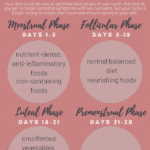
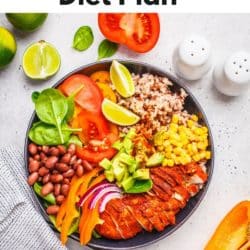
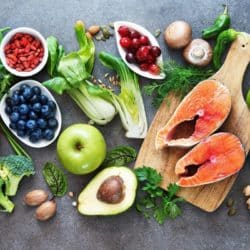


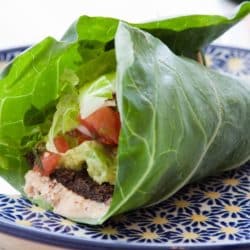


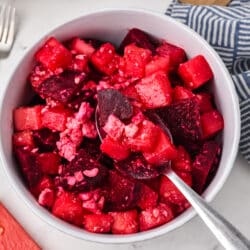
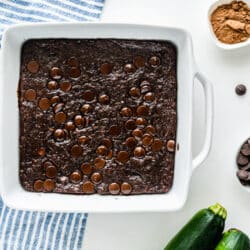
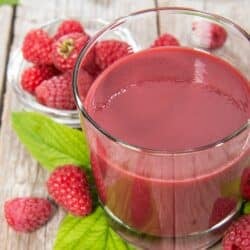
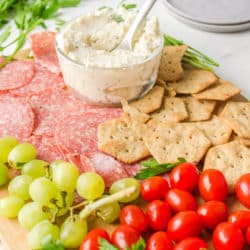


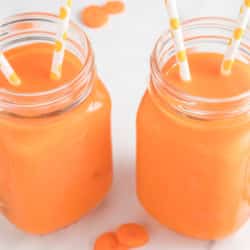




I’m really keen and interested in cycling. However, I have a hormonal mirena coil so I don’t think I cycle anymore? Or am I constantly stuck in one stage of the cycle?
My understanding is that you can still eat according to a regular cycle, but you won’t ovulate or have a period because of the IUD. But you can still follow the plan as if you are cycling. And, you can always have the IUD removed if you want to actually start cycling again…but then of course you won’t have the benefits of birth control. But please ask your doctor for more info! 🙂
This is such a fantastic start. I would love to have lists of food for each phase. It leaves me with a lot of questions and in a sense confusion. With so many styles of eating out there “nutrient dense anti-inflammatory food” could mean so many different things.
What options does a premenapuasal women who had a partial hysterectomy to remove their uterus but still has their ovaries follow?
Similarly, is there something similar a postmenopausal woman should follow?
Unless there are other health concerns that need addressing, women who do not menstruate should simply follow a mostly real food, unprocessed diet. No real need to adjust for phases without menstruation. Does that answer your question?
I’m just beginning my journey on eating per cycle phase and getting the most out of food to maintain balanced hormone levels. My question however, is if I’m cooking for myself as well and my man regularly, and I stick with the cycle eating, is that going to mess up his hormones?
Great question! It won’t mess up his hormones, but he’ll benefit from all of the real foods.
What to eat during pregnancy?
I was just talking to a friend about this yesterday. I have to share this with her. Good stuff.
This is a very helpful post. I am done with menstrual cycles and all, so sharing this post with my daughter and my niece would be the next best thing to do. My high school best friend’s daughter has PCOS, and I am following that link you shared too. I know it will be a big help for her.
I wish I would have know this information when I had a cycle. This info is great and all women with a menstrual cycle should read it. Thanks for sharing. I’m passing it along to my daughter.
What about girls with pcos. Can we follow the same diet plan ?
Yes, this is appropriate for PCOS, but you might want to check out this article that is more specific about diet and PCOS: https://www.cleaneatingkitchen.com/pcos-diet/
This was so informative. Thank you!
You’re so welcome, Sue! I wish I had known all of this 20 years ago.